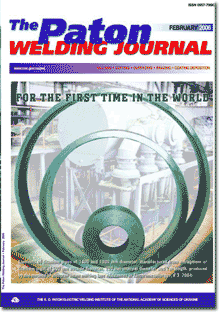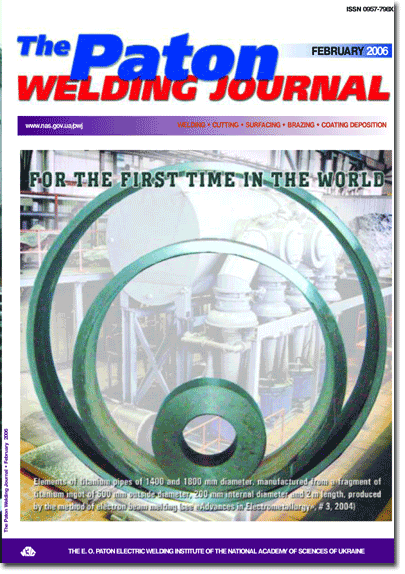

| SCIENTIFIC AND TECHNICAL | |
| Shelyagin V.D., Khaskin V.Yu. and Pereverzev Yu.N. Laser-microplasma alloying and coating of steel | 2 |
| The hybrid process is suggested for laser-microplasma alloying and coating. The process is free from drawbacks of laser cladding and microplasma spraying. Main parameters, characteristic structure of the transition zone and distribution of microhardness were determined. | |
| Dmitrik V.V., Tsaryuk A.K., Bugaets A.A. and Grinchenko E.D. Evaluation of remaining life of welded joints of pipelines for thermal power plants | 6 |
| Structure and properties of welded joints in heat-resistant steel 15Kh1M1F after long-time operation are described. An estimate of damageability of the joints and a negative forecast of further operation are given. | |
| Dilthey U., Gumenyuk A.V. and Turichin G.A. Calculation of the kinetics of diffusion phase transformations in low-alloyed steels in beam welding | 11 |
| Parametric description of TTT- and CCT-diagrams has been developed on the basis of the results of growth of cementite inclusions and redistribution of carbon in the ferritic phase under non-equilibrium conditions for welding of steels at high cooling rates. The model has been developed to estimate the effect of initial structure of a material and parameters of the thermal cycles on the transformation diagrams. | |
| Maksimov S.Yu., But V.S., Vasiliev V.G., Zakharov S.M. and Zajtseva N.V. Structure changes in HAZ metal of steel X60 welded joints in underwater welding | 16 |
| Phase composition of the HAZ microstructure in welded joints of steel X60, made under the water, was evaluated proceeding from analysis of the diagram of anisothermal transformation of austenite and results of metallographic examination. It is established that at cooling rates characteristic of the conditions of underwater welding, in HAZ martensite structure inevitably develops, which determines brittle nature of a welded joint failure under the impact of external load. | |
| Markashova L.I., Grigorenko G.M., Ishchenko A.Ya., Lozovskaya A.V. and Kushnaryova O.S. Effect of scandium additions on fine structure of weld metal in aluminium alloy 1460 welded joints | 20 |
| Peculiarities of structure-phase condition of metal of the welds and welded joints made on alloy 1460 by argon-arc welding using standard filler wire Sv1201 and experimental wire 1201 with an addition of scandium were studied by transmission electron microscopy. Main structural changes caused by adding scandium are characterised by grain refining, increase in volume density of dislocations, formation of fine inclusions containing scandium, and activation of solid solution decomposition processes. | |
| Poklyatsky A.G., Lozovskaya A.V., Grinyuk A.A., Yavorskaya M.R. and Chajka A.A. Improvement of weld strength in arc welding of AlДCu alloys with application of Sc-containing fillers | 26 |
| Comparative analysis of mechanical properties of deposited metal produced by using filler wires of Sv1201 type with different content of copper and scandium has been performed. It is shown that addition of 0.5 % Sc to welding wires creates prerequisites for an extra increase in tensile strength and proof stress of the welds. Methods are suggested to provide an extra increase of the strength of welded joints and weld metal directly during the welding process by passing current through a section of the filler and using postweld heat treatment by a special mode. | |
| INDUSTRIAL | |
| Garashchuk V.P. and Shelyagin V.D. Current trends in development of technological lasers | 30 |
| Current trends in development of technological CO2-lasers, optically excited sold-state lasers and semiconductor lasers are analysed on the basis of the information obtained at Fair «Laser-2005» and Essen Fair «Schweissen and Schneiden». Technological parameters of fibre and semiconductor lasers have been improved in the last years, while those of CO2-lasers have remained almost unchanged. Two-coordinate scanning is additionally applied in technological systems based on the Cartesian manipulators. In welding technologies, the special consideration is given to combined welding methods, characterised by combined application of laser radiation and other heat sources, such as electric arc, non-coherent light sources, etc. | |
| Golovko V.V. Methods to lower the hydrogen content in metal of welded joints of low-alloyed steels in submerged-arc welding | 33 |
| The paper gives the results of thermodynamic calculations of probable metallurgical reactions in submerged-arc welding using agglomerated fluxes, which promote lowering of partial pressure of hydrogen within the arcing zone and suppressing the diffusivity of hydrogen in the weld. They are in good agreement with experimental data. It is concluded that the use of fused intermediate products is advantageous for production of welding fluxes, in order to decrease the hydrogen content of weld metal. | |
| Kuzmenko V.G. and Guzej V.I. Sanitarian-hygienic characteristics of welding fluxes with locally changed chemical composition of grains | 37 |
| Intensity if formation of welding aerosol and its composition in submerged arc welding using fused flux AN-60 containing fluoride added by different methods, e.g. by adding fluoride raw materials to the charge followed by its melting in furnace, or by heat treatment in the fluorine-containing gases, namely products of decomposition of ammonium fluoride NH4F, are studied. | |
| Rosert R. and Alimov A. Production and application of flux-cored wire in Ukraine | 40 |
| BRIEF INFORMATION | |
| Balin A.N., Berezovsky A.V., Vishnevsky A.A. and Kulishenko B.A. Surfacing consumables for hardening of parts operating under impact-abrasive wear conditions | 44 |
| Data are given on flux-cored wires and electrodes used as surfacing consumables for hardening of parts operating under impact-abrasive wear conditions. | |
| Skorina N.V. and Marchenko A.E. Reactivity of ferroalloys in liquid glass | 46 |
| The results of investigation into reactivity of fine ferroalloys (ferrosilicium FS-45, ferromanganese, ferrosilicomanganese, etc.) used in production of electrodes as weld metal deoxidizers and alloying elements of the weld metal, are presented. Individual batches of ferrosilicium FS-45 were revealed to have an extremely high reactivity. It was suggested that such high reactivity might be associated with peculiarities of the production technology, which could either deteriorate homogeneity of ferrosilicium ingots or cause formation of particularly reactive structural components. | |
| Developed at PWI | 5 10 19 45 |
(You are viewing the simplified file contents)
The cost of subscription/purchase order journals or individual articles
| Journal/Currency | Annual Set | 1 issue printed |
1 issue |
one article |
| TPWJ/USD | 384 $ | 32 $ | 26 $ | 13 $ |
| TPWJ/EUR | 348 € | 29 € | 24 € | 12 € |
| TPWJ/UAH | 7200 UAH | 600 UAH | 600 UAH | 280 UAH |
| AS/UAH | 1800 UAH | 300 UAH | 300 UAH | 150 UAH |
| AS/USD | 192 $ | 32 $ | 26 $ | 13 $ |
| AS/EUR | 180 € | 30 € | 25 € | 12 € |
| SEM/UAH | 1200 UAH | 300 UAH | 300 UAH | 150 UAH |
| SEM/USD | 128 $ | 32 $ | 26 $ | 13 $ |
| SEM/EUR | 120 € | 30 € | 25 € | 12 € |
| TDNK/UAH | 1200 UAH | 300 UAH | 300 UAH | 150 UAH |
| TDNK/USD | 128 $ | 32 $ | 26 $ | 13 $ |
| TDNK/EUR | 120 € | 30 € | 25 € | 15 € |
AS = «Automatic Welding» - 6 issues per year;
TPWJ = «PATON WELDING JOURNAL» - 12 issues per year;
SEM = «Electrometallurgy Today» - 4 issues per year;
TDNK = «Technical Diagnostics and Non-Destructive Testing» - 4 issues per year.


